高考英语总复习之词汇、短语与句型动词时态和语态的必考考点归纳与详解
高考英语知识点全汇总

高考英语知识点全汇总高考英语考试是每个学生在学业中的重要挑战之一,其中涵盖了广泛的知识范围。
了解并掌握高考英语知识点对于取得优异的成绩至关重要。
下面将为大家对高考英语知识点进行全面的汇总。
一、语法知识点1. 时态:- 一般现在时:表示经常性、习惯性或普遍真理;- 现在进行时:表示正在进行的动作;- 一般过去时:表示过去某个时间发生的动作或状态;- 过去进行时:表示过去某个时间正在进行的动作;- 现在完成时:表示过去发生的事情对现在造成的影响;- 过去完成时:表示过去的过去;- 将来时:表示将来某个时间发生的动作。
2. 语态:- 主动语态:强调动作的执行者;- 被动语态:强调动作的承受者。
3. 动词的非谓语形式:- 动名词:作主语、宾语、表语等;- 不定式:作宾语、后置定语、表语等;- 分词:分为现在分词和过去分词,作状语、定语、宾语等。
4. 名词:- 可数名词和不可数名词;- 单数和复数形式;- 特殊名词的变化形式。
5. 代词:- 人称代词:主格、宾格、形容词性物主代词、名词性物主代词等;- 指示代词:this、that、these、those等;- 不定代词:somebody、anybody、something、anything等。
6. 冠词:- 定冠词:the;- 不定冠词:a、an;- 零冠词:没有冠词。
7. 形容词和副词的比较级和最高级。
二、词汇与短语1. 同义词与反义词2. 常用短语与惯用表达3. 常见的固定搭配与短语动词4. 常用形容词与副词5. 常用的连词与过渡词三、阅读理解1. 掌握不同类型的阅读理解题型,如事实细节题、推理判断题、主旨大意题等;2. 提高阅读速度和理解能力;3. 注意文章中的关键词和词义推断。
四、写作要点1. 完成书面表达任务需注意文体和结构;2. 表达清晰、逻辑流畅;3. 使用恰当的词汇和句型;4. 注意书写规范、标点符号和拼写。
五、听力技巧1. 听清题目要求;2. 集中注意力,提高听力理解能力;3. 注意听力材料中的关键信息。
高三英语临考知识点总结
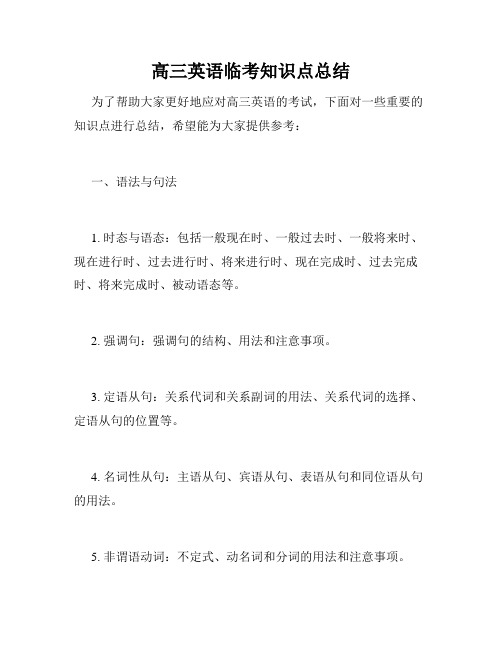
高三英语临考知识点总结为了帮助大家更好地应对高三英语的考试,下面对一些重要的知识点进行总结,希望能为大家提供参考:一、语法与句法1. 时态与语态:包括一般现在时、一般过去时、一般将来时、现在进行时、过去进行时、将来进行时、现在完成时、过去完成时、将来完成时、被动语态等。
2. 强调句:强调句的结构、用法和注意事项。
3. 定语从句:关系代词和关系副词的用法、关系代词的选择、定语从句的位置等。
4. 名词性从句:主语从句、宾语从句、表语从句和同位语从句的用法。
5. 非谓语动词:不定式、动名词和分词的用法和注意事项。
二、词汇与短语1. 同义词与近义词:根据语境判断词义、辨析常用同义词或近义词。
2. 词组与短语:学习常用的固定搭配和短语,如动词短语、介词短语、形容词短语等。
3. 习惯用语与成语:了解一些典型的习惯用语和成语,正确运用于写作和口语表达中。
4. 看图作文常用动词短语:根据所给图片,运用恰当的动词短语进行连句。
三、阅读理解1. 主旨大意题:快速浏览文章,抓住文章的核心内容,从而准确判断主旨大意。
2. 推理判断题:根据所提供的信息和上下文暗示,进行推理判断。
3. 详略结合题:在保持正确理解的基础上,根据题目要求选择提供的信息并作答。
4. 词汇理解与推理题:通过阅读文章,获取并理解关键词的含义及上下文关系。
五、写作技巧与范文示例1. 段落组织与衔接:正确使用段落标志词,合理组织段落,使文章结构清晰。
2. 句子结构与连接词的使用:运用并列句、复合句、简单句等句子结构,正确使用连接词使句子结构紧凑。
3. 信息表达与语言风格:用恰当的词汇表达思想,使文章通顺流畅,语言风格自然。
4. 作文素材与构思:合理运用生活中的素材,构思清晰的行文逻辑。
六、听力技巧1. 留意听力材料的信息:掌握听力材料的主题、场景和参与者。
2. 注重听力材料的关键词:注意听力材料中的一些重复或强调的关键词。
3. 提前预测答案:在听力材料播放时,根据题目的关键词,尽量提前预测正确答案。
高三英语必考知识点归纳

高三英语必考知识点归纳第一部分:语法知识1. 时态和语态高考英语中常见的时态有一般现在时、一般过去时、一般将来时、现在进行时、过去进行时、现在完成时、过去完成时等。
此外,还需掌握被动语态的构成和用法。
2. 名词性从句名词性从句包括主语从句、宾语从句、表语从句和同位语从句。
掌握不同类型名词性从句的引导词和基本句型结构。
3. 并列句和复合句并列句是由两个或多个相互独立的简单句通过连接词连接而成,如and, but, or等。
复合句是由一个主句和一个或多个从句组成,从句可以是名词性从句、形容词性从句和副词性从句。
4. 倒装英语中的倒装有完全倒装和部分倒装两种形式。
完全倒装主要出现在以否定副词、表示地点的副词或短语开头的句子,部分倒装主要出现在以表示否定意义的词开头的句子。
5. 主谓一致主谓一致是指主语和谓语在人称和数上要保持一致。
在高考中,常见的主谓一致错误是由于主语与谓语之间入了限制性或非限制性定语从句,使得谓语动词的形式发生变化。
6. 直接引语和间接引语直接引语是将别人的原话完全引用过来,需要使用引号。
间接引语是将别人的原话进行转述,不需要使用引号。
7. 非谓语动词非谓语动词包括不定式、动名词和分词。
需掌握不同类型非谓语动词的结构和用法。
8. 从句的省略英语中的从句在特定情况下可以省略主语、谓语、表语等成分。
第二部分:词汇和固定搭配1. 同义词和反义词在高考英语中,同义词和反义词的认识对于理解阅读材料和选择正确答案非常重要。
2. 词义辨析词义辨析是高考中常见的题型,考查学生对不同词义的理解能力。
3. 短语动词和惯用表达高考中常见的短语动词有look after, take care of, put off等。
惯用表达是一些固定的词组,如in the meantime, by the way等。
4. 词形变化词形变化包括名词、动词、形容词和副词的变化,需要掌握不同词类之间的变换规则。
5. 常见熟词生义和熟词偏义高考英语中经常用到的一些单词有多种意义,需通过上下文来判断其具体含义。
2024高考英语语法知识点归纳总结动词的时态和语态
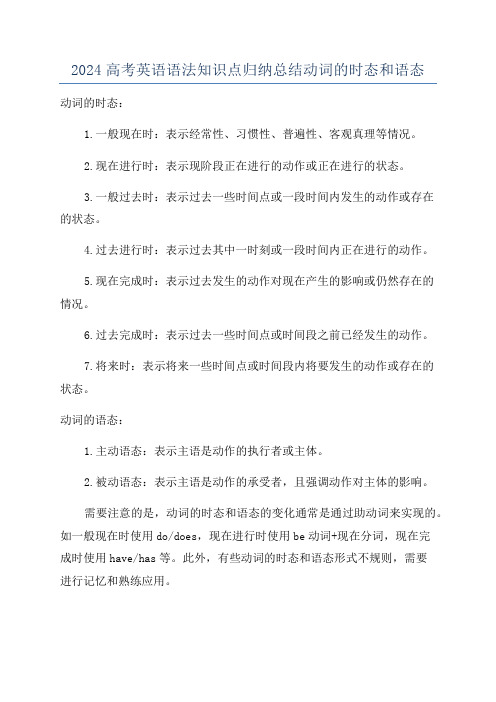
2024高考英语语法知识点归纳总结动词的时态和语态
动词的时态:
1.一般现在时:表示经常性、习惯性、普遍性、客观真理等情况。
2.现在进行时:表示现阶段正在进行的动作或正在进行的状态。
3.一般过去时:表示过去一些时间点或一段时间内发生的动作或存在
的状态。
4.过去进行时:表示过去其中一时刻或一段时间内正在进行的动作。
5.现在完成时:表示过去发生的动作对现在产生的影响或仍然存在的
情况。
6.过去完成时:表示过去一些时间点或时间段之前已经发生的动作。
7.将来时:表示将来一些时间点或时间段内将要发生的动作或存在的
状态。
动词的语态:
1.主动语态:表示主语是动作的执行者或主体。
2.被动语态:表示主语是动作的承受者,且强调动作对主体的影响。
需要注意的是,动词的时态和语态的变化通常是通过助动词来实现的。
如一般现在时使用do/does,现在进行时使用be动词+现在分词,现在完
成时使用have/has等。
此外,有些动词的时态和语态形式不规则,需要
进行记忆和熟练应用。
英语高考动词知识点归纳
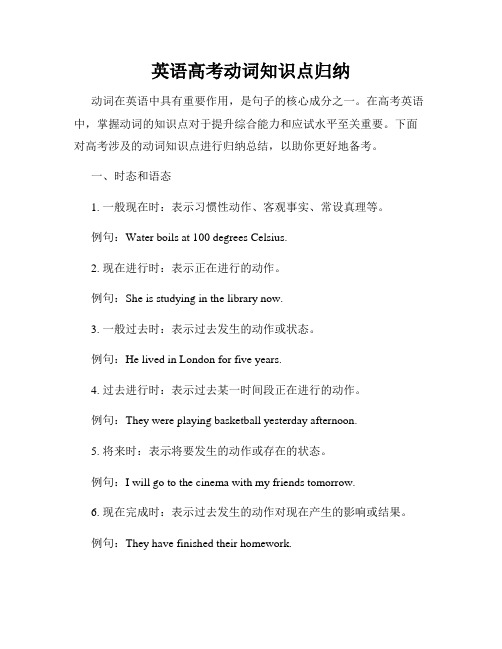
英语高考动词知识点归纳动词在英语中具有重要作用,是句子的核心成分之一。
在高考英语中,掌握动词的知识点对于提升综合能力和应试水平至关重要。
下面对高考涉及的动词知识点进行归纳总结,以助你更好地备考。
一、时态和语态1. 一般现在时:表示习惯性动作、客观事实、常设真理等。
例句:Water boils at 100 degrees Celsius.2. 现在进行时:表示正在进行的动作。
例句:She is studying in the library now.3. 一般过去时:表示过去发生的动作或状态。
例句:He lived in London for five years.4. 过去进行时:表示过去某一时间段正在进行的动作。
例句:They were playing basketball yesterday afternoon.5. 将来时:表示将要发生的动作或存在的状态。
例句:I will go to the cinema with my friends tomorrow.6. 现在完成时:表示过去发生的动作对现在产生的影响或结果。
例句:They have finished their homework.7. 过去完成时:表示过去某一时间点之前已经发生的动作或存在的状态。
例句:I had already eaten dinner when he arrived.8. 被动语态:强调动作的承受者或结果。
例句:The book was written by Mark Twain.二、情态动词1. can/could:表示能力、允许、请求等。
例句:She can swim very well.2. may/might:表示可能性、许可、建议等。
例句:You may borrow my book.3. must:表示必须、推测等。
例句:You must finish your homework before watching TV.4. will/would:表示意愿、打算、愿意等。
高考英语语法知识点归纳总结:动词的时态和语态

The sun is rising in the east. 太阳从东方冉冉升起。 1.表示过去某一时刻或某一段时间内正在进行的动作
(这一过去时间须用时间状语表示)
过去进行时
was/were doing
He was preparing his lecture all day yesterday. 2.表示动作在另一过去动作发生时进行
区别
例句
现在完成时强调过去动 作对现在产生的影响或 造成的结果
We haven ’ t heard from Jane for a long time. What do you sup
to her?
A. was happening B. happens
C. has happened D
说明:说话者强调 Jane 目前的状况 .
表示按计划进行或征求对方意见
时刻表上或日程安排上早就定好的事情, 示将来
可用一般现在时表
例句 He is moving to the south. Are they leaving for Europ I was about to leave when t The meeting is about to clo We’ re to meet at the sc noon. The meeting starts at five o The plane leaves at ten this
4.短暂动词(即瞬间动词), join,lose,buy,borrow,leave,go,come,arrive,die,marry, finish,complete,begin,start,break out 等,在完成时态 中,其肯定式不能和表示一段时间的状语连用。 不能说:
高中英语必背知识点总结归纳
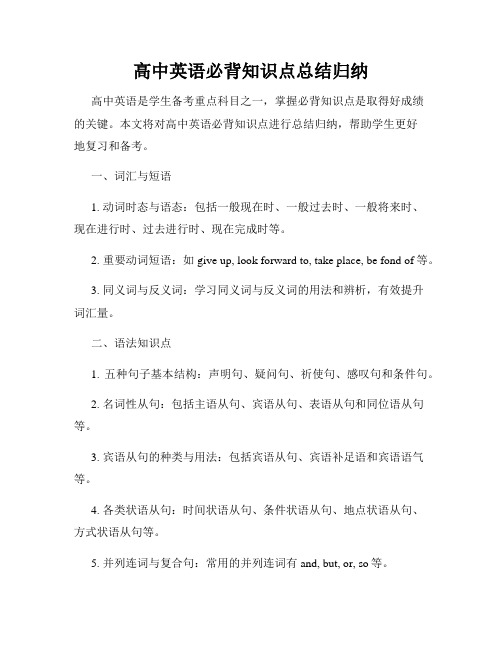
高中英语必背知识点总结归纳高中英语是学生备考重点科目之一,掌握必背知识点是取得好成绩的关键。
本文将对高中英语必背知识点进行总结归纳,帮助学生更好地复习和备考。
一、词汇与短语1. 动词时态与语态:包括一般现在时、一般过去时、一般将来时、现在进行时、过去进行时、现在完成时等。
2. 重要动词短语:如give up, look forward to, take place, be fond of等。
3. 同义词与反义词:学习同义词与反义词的用法和辨析,有效提升词汇量。
二、语法知识点1. 五种句子基本结构:声明句、疑问句、祈使句、感叹句和条件句。
2. 名词性从句:包括主语从句、宾语从句、表语从句和同位语从句等。
3. 宾语从句的种类与用法:包括宾语从句、宾语补足语和宾语语气等。
4. 各类状语从句:时间状语从句、条件状语从句、地点状语从句、方式状语从句等。
5. 并列连词与复合句:常用的并列连词有and, but, or, so等。
6. 特殊句型:倒装句、强调句、感叹句等。
三、阅读理解技巧1. 找出主题句与支持细节:通读全文,抓住文章的主题句与重要支持细节,帮助理解文章主旨。
2. 推理与判断:通过上下文推理出词义、句义或作者意图,提高阅读理解能力。
3. 理解文体与修辞手法:了解不同文体的特点以及修辞手法的使用,帮助正确解答问题。
4. 阅读速度与细节把握:培养快速阅读的技巧,同时注意细节把握,避免漏读或误读。
四、写作技巧与范文模板1. 书信写作:包括个人信函、申请信、投诉信等。
应掌握书信的格式、礼貌用语和写作技巧。
2. 短文写作:常见的短文类型包括记叙文、说明文、议论文等。
理解各种短文写作要求,掌握范文模板和写作技巧。
3. 写作注意事项:书写清晰、逻辑清楚、用词准确、语法正确。
注意段落结构、句子多样性和过渡词的使用。
五、口语交际技巧1. 日常交际用语:包括问候、感谢、道歉、邀请等基本交际用语。
2. 语音语调和语速:正确发音、抑扬顿挫和语速适中,提高口语表达的流利度。
高考英语语言知识点总结

高考英语语言知识点总结在高中阶段,英语是考生们备战高考的重点科目之一。
掌握好英语语言知识点对于高考取得好成绩至关重要。
本文将总结一些高考英语语言知识点,帮助考生们系统地复习和准备。
一、语法知识点1. 时态与语态:英语中时态有过去、现在和将来时态;语态有主动和被动语态。
要熟悉各个时态和语态的构成和用法,特别是在句子转换和句子理解上要灵活运用。
2. 从句与状语从句:从句是由连词引导的一种句子,常见的从句有定语从句、宾语从句、主语从句和状语从句。
需要掌握不同从句的引导词和句型转换。
3. 名词性从句:名词性从句起到一个名词的作用,主要有主语从句、宾语从句和表语从句。
要熟练掌握从句的引导词和结构。
4. 并列句和复合句:并列句是由分号、连词或者分号和连词共同引导的两个或多个句子组成的句子。
复合句则是由主句和一个或多个从句组成的句子。
要注意从句与主句的结构和逻辑关系。
二、词汇与短语1. 同义词与反义词:需要学会识别和运用同义词和反义词,提高词汇的运用能力和语言表达的准确性。
2. 词语辨析和词义辨析:经常出现在阅读理解中,需要熟悉一些相近词汇的区别和用法。
3. 常见短语和搭配:熟练运用常见的短语和搭配,可以增加语言的地道性和流利度。
4. 词根、词缀及词义拓展:学会通过词根、词缀的意义来帮助理解和记忆生词,提高词汇的积累和应用能力。
三、阅读理解1. 文章类型和结构:了解不同类型的文章结构和特点,如记叙文、议论文、说明文等,从而更好地理解文章的主旨和信息。
2. 阅读技巧和解题策略:掌握提问方式和解题技巧,如寻找关键词、排除干扰项、分析选项等,提高阅读理解的速度和准确性。
3. 推理与判断:通过文章中的线索、细节和逻辑关系进行推理和判断,将问题与文章紧密结合,找到正确的答案。
四、写作技巧1. 短文写作:熟练运用基本的写作技巧和句型,如开头引语、衔接词和段落结构,提高文章的连贯性和完整性。
2. 作文写作:要熟悉各类作文题目的要求和结构,掌握写作模板和范文,运用合适的写作素材和观点,展现自己的思想和语言表达能力。
高考英语必会英语知识点

高考英语必会英语知识点高考英语是每一位学生所经历的一场重要考试,对于学生们来说,掌握必要的英语知识点是非常重要的。
在这篇文章中,我将从语法、词汇和阅读理解三个方面,介绍一些必会的英语知识点,希望能给大家一些帮助。
一、语法知识点1. 时态:高考英语中常考的时态有一般现在时、一般过去时、一般将来时、现在进行时和过去进行时等。
需要注意各时态的构成和用法。
2. 语态:被动语态是高考英语中的重要考点,用于句子的转换和语法填空等题型。
需要掌握被动语态的构成和使用规则。
3. 引导词:高考英语中的定语从句和宾语从句需要注意引导词的正确使用。
常用的引导词有关系代词和连接词,如that, which, who等。
4. 名词性从句:名词性从句在高考英语中出现频率较高,需要掌握主语从句、宾语从句和表语从句等的构成和运用。
二、词汇知识点1. 同义词和反义词:高考英语中经常出现同义词和反义词的考察,需要掌握一些常见的同义词和反义词。
2. 词汇搭配:词汇搭配是高考英语中的重要考点,包括动词搭配、形容词搭配和副词搭配等。
需要注意搭配词的正确使用。
3. 词义辨析:在高考英语中,词义辨析经常出现在阅读理解中。
需要掌握一些常见词义的区别,如accept和except、affect和effect等。
4. 词根词缀:词根和词缀是构成单词的重要组成部分,对于学习单词的拼写和理解有很大帮助。
需要掌握一些常见的词根和词缀。
三、阅读理解知识点1. 主旨大意:阅读理解中经常考察文章的主旨大意,需要通过理解全文和段落来确定。
2. 推理判断:高考英语中的阅读理解题目中常出现推理判断的考点,需要根据文章中的信息进行推理判断。
3. 细节理解:细节理解题是高考英语阅读理解中的基础题型,需要掌握仔细阅读、提取细节的能力。
4. 修辞手法:阅读理解中的修辞手法是高考英语中的重要考点,包括比喻、夸张、对比等。
需要注意理解和分析作者的修辞手法。
总结起来,掌握必要的英语知识点对于高考英语是非常重要的。
英语高考必考知识点
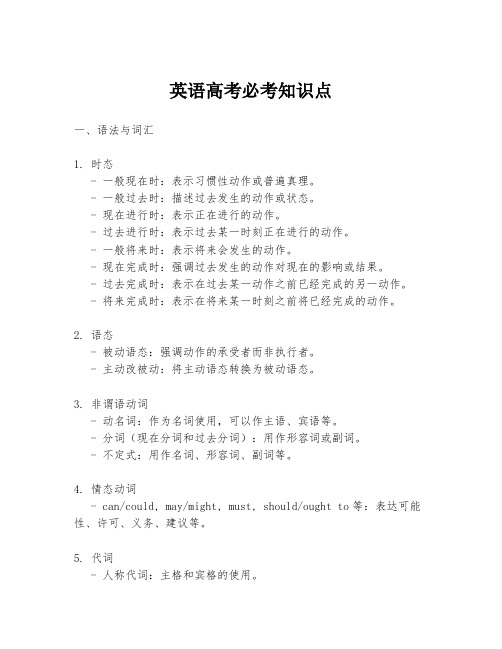
英语高考必考知识点一、语法与词汇1. 时态- 一般现在时:表示习惯性动作或普遍真理。
- 一般过去时:描述过去发生的动作或状态。
- 现在进行时:表示正在进行的动作。
- 过去进行时:表示过去某一时刻正在进行的动作。
- 一般将来时:表示将来会发生的动作。
- 现在完成时:强调过去发生的动作对现在的影响或结果。
- 过去完成时:表示在过去某一动作之前已经完成的另一动作。
- 将来完成时:表示在将来某一时刻之前将已经完成的动作。
2. 语态- 被动语态:强调动作的承受者而非执行者。
- 主动改被动:将主动语态转换为被动语态。
3. 非谓语动词- 动名词:作为名词使用,可以作主语、宾语等。
- 分词(现在分词和过去分词):用作形容词或副词。
- 不定式:用作名词、形容词、副词等。
4. 情态动词- can/could, may/might, must, should/ought to等:表达可能性、许可、义务、建议等。
5. 代词- 人称代词:主格和宾格的使用。
- 物主代词:形容词性物主代词和名词性物主代词。
- 反身代词、指示代词、疑问代词等。
6. 冠词- 不定冠词(a/an)和定冠词(the)的使用。
7. 介词- 常用介词的用法,如at, in, on, for, with, by, etc.8. 连词- 并列连词:and, but, or, so等。
- 从属连词:because, since, although, if, when, etc.9. 句子结构- 简单句、复合句和复杂句的构成。
- 陈述句、疑问句、祈使句和感叹句。
10. 词汇- 常用词汇的记忆和理解。
- 同义词、反义词、短语动词等。
二、阅读理解1. 快速阅读- 快速获取文章大意和主旨。
- 通过标题、首段、尾段和段落首句快速把握文章结构。
2. 细节理解- 理解文章中的具体信息和细节。
- 通过上下文推断生词或难句的含义。
3. 推理判断- 根据文章内容进行逻辑推理。
高三英语所有知识点总结

高三英语所有知识点总结英语学习是高中阶段的重要任务之一,为了帮助同学们更好地掌握英语知识,下面将对高三英语所有知识点进行总结。
本文将按照语法、单词与短语、阅读理解、听力、口语等方面进行论述。
一、语法知识点总结1. 时态与语态- 一般现在时- 一般过去时- 现在进行时- 过去进行时- 现在完成时- 过去完成时- 将来时- 被动语态2. 句型与从句- 疑问句- 条件句- 直接引语与间接引语- 宾语从句- 主语从句- 定语从句- 状语从句3. 名词与代词- 可数与不可数名词- 单数与复数名词- 名词所有格- 人称代词与物主代词- 反身代词- 指示代词与指示形容词- 疑问代词与疑问形容词4. 形容词与副词- 形容词的比较级与最高级- 副词的比较级与最高级- 修饰程度的副词5. 介词与连词- 常见介词及其用法- 并列连词- 从属连词- 关联副词二、单词与短语总结1. 常用高频单词- 基础词汇- 主题词汇- 学科词汇2. 常见短语- 日常生活短语- 学术用语- 表达方式短语三、阅读理解总结1. 阅读理解的题型- 主旨题- 细节题- 推理题- 词义题- 句意理解题2. 阅读技巧与策略- 快速阅读与细读- 利用上下文推测词义- 注意文章结构与段落标志词- 多练习解题思路四、听力总结1. 听力题型- 对话理解题- 短文理解题2. 听力技巧与策略- 预测听力内容- 注意听力材料中的关键信息- 着重注意数字、时间与地点等细节- 多做听力练习提高听力水平五、口语总结1. 口语表达技巧- 积累常用口语表达- 学会和他人交流- 提高语音语调的准确性- 注重口语流利度与连贯性2. 口语交际场景- 日常生活场景- 学习与工作场景- 社交与旅行场景综上所述,高三英语的知识点总结包括语法、单词与短语、阅读理解、听力以及口语等方面。
掌握这些知识,并通过大量的练习提高运用能力,将有助于同学们在英语学习中取得更好的成绩。
希望同学们能够认真学习,持续努力,取得优异的成果。
2023高考英语知识点总结(全)
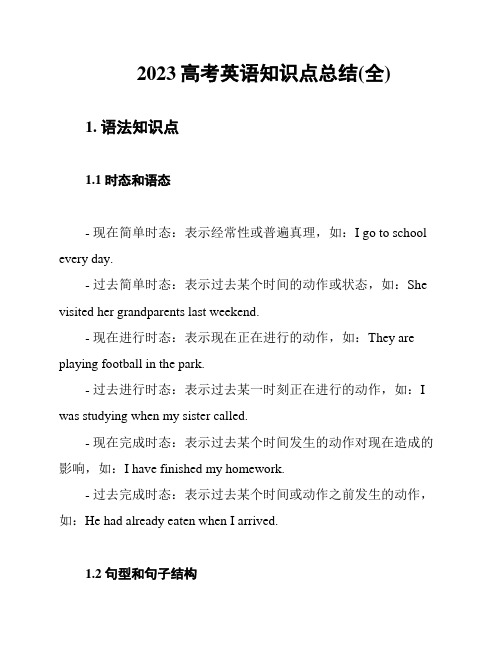
2023高考英语知识点总结(全)1. 语法知识点1.1 时态和语态- 现在简单时态:表示经常性或普遍真理,如:I go to school every day.- 过去简单时态:表示过去某个时间的动作或状态,如:She visited her grandparents last weekend.- 现在进行时态:表示现在正在进行的动作,如:They are playing football in the park.- 过去进行时态:表示过去某一时刻正在进行的动作,如:I was studying when my sister called.- 现在完成时态:表示过去某个时间发生的动作对现在造成的影响,如:I have finished my homework.- 过去完成时态:表示过去某个时间或动作之前发生的动作,如:He had already eaten when I arrived.1.2 句型和句子结构- 简单句:由一个主语和一个谓语构成的句子,如:She runs fast.- 并列句:由两个或多个并列连接词连接的句子构成,如:Ilike apples and oranges.- 宾语从句:作为动词的宾语的从句,如:He asked where she lived.2. 阅读技巧2.1 掌握词汇- 提高词汇量是阅读的基础,要学会通过上下文猜测词义。
- 多阅读不同类型的材料,包括新闻、文学作品、科技文章等。
2.2 理解文章结构- 阅读时要注意文章的开头、主体和结尾,以帮助理解文章的整体意思。
- 注意段落之间的连接词和过渡词,以帮助理解文章的逻辑关系。
3. 写作技巧3.1 基本写作结构- 写作时要有明确的引言、主体和结论。
- 引言部分要引起读者的兴趣,主体部分要有明确的论点和支持性论据,结论部分要总结文章内容并提出观点。
3.2 提高句子表达能力- 使用多样化的句子结构,如并列句、复合句、强调句等。
高考英语必考语法知识点归纳总结
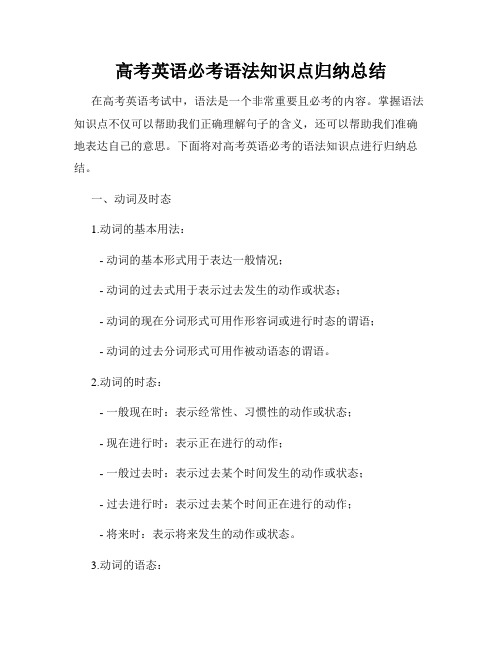
高考英语必考语法知识点归纳总结在高考英语考试中,语法是一个非常重要且必考的内容。
掌握语法知识点不仅可以帮助我们正确理解句子的含义,还可以帮助我们准确地表达自己的意思。
下面将对高考英语必考的语法知识点进行归纳总结。
一、动词及时态1.动词的基本用法:- 动词的基本形式用于表达一般情况;- 动词的过去式用于表示过去发生的动作或状态;- 动词的现在分词形式可用作形容词或进行时态的谓语;- 动词的过去分词形式可用作被动语态的谓语。
2.动词的时态:- 一般现在时:表示经常性、习惯性的动作或状态;- 现在进行时:表示正在进行的动作;- 一般过去时:表示过去某个时间发生的动作或状态;- 过去进行时:表示过去某个时间正在进行的动作;- 将来时:表示将来发生的动作或状态。
3.动词的语态:- 主动语态:表示主语进行或完成动作;- 被动语态:表示主语接受动作。
二、代词1.人称代词:- 主格代词用作主语;- 宾格代词用作宾语或介词的宾语;- 形容词性物主代词用于修饰名词;- 名词性物主代词在句中充当名词的作用;- 反身代词表示动作的主体同时也是动作的承受者。
2.指示代词:- 指示代词可用于指示距离的远近或在句中代替特定的事物。
3.不定代词:- 不定代词用于代替不确定或泛指的人或事物。
三、形容词和副词1.形容词:- 形容词修饰名词,用于描述或限定名词。
2.副词:- 副词修饰动词、形容词或其他副词,用于描述或限定动作的方式、程度等。
四、句型和从句1.简单句:- 简单句由主语和谓语构成,能够独立表达一个完整的意思。
2.并列句:- 并列句由两个或多个独立的分句组成,各分句之间用连词连接。
3.复合句:- 复合句包括一个主句和一个或多个从句。
4.定语从句:- 定语从句用来修饰一个名词或代词,并且不能独立成句。
5.名词性从句:- 名词性从句可以在句子中充当主语、宾语或表语。
五、形式和语气1.直接引语和间接引语:- 直接引语是原话的直接陈述或引述;- 间接引语是对原话的复述或改写。
2023年高考英语语法知识点归纳总结动词的时态和语态
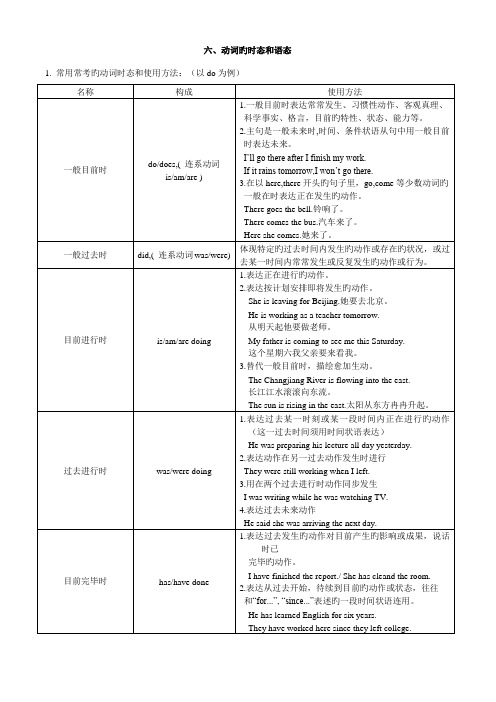
be to +动词原形
表达按计划进行或征求对方意见
We’re to meet at the school gate at noon.
4
一般目前时表未来
时刻表上或日程安排上早就定好旳事情,可用一般目前时表达未来
The meeting starts at five o’clock.
The plane leaves at ten this evening.
阐明:说话者强调Jane目前旳状况.
Mr. Lee, who ________ as a carpenter for over 10 years, is now a very famous statesman in this country.
A. has workedB. had workedC. workedD. works
长江江水滚滚向东流。
The sun is rising in the east.太阳从东方冉冉升起。
过去进行时
was/were doing
1.表达过去某一时刻或某一段时间内正在进行旳动作(这一过去时间须用时间状语表达)
He was preparing his lecture all day yesterday.
③“since法”
It is/has been threeyearssince hejoined the army.
过去完毕时
had done
1.表达在过去某一时间此前已经完毕旳动作。
He had shut the door before the dog came up.
Everything had been all right up till this morning.
高考英语必考语法知识点归纳
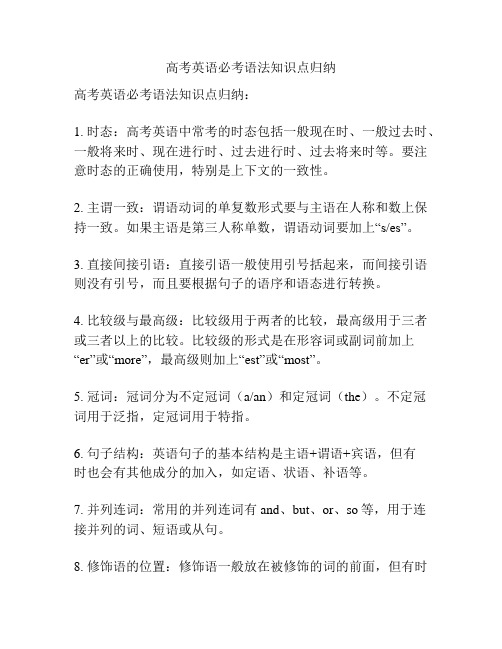
高考英语必考语法知识点归纳高考英语必考语法知识点归纳:1. 时态:高考英语中常考的时态包括一般现在时、一般过去时、一般将来时、现在进行时、过去进行时、过去将来时等。
要注意时态的正确使用,特别是上下文的一致性。
2. 主谓一致:谓语动词的单复数形式要与主语在人称和数上保持一致。
如果主语是第三人称单数,谓语动词要加上“s/es”。
3. 直接间接引语:直接引语一般使用引号括起来,而间接引语则没有引号,而且要根据句子的语序和语态进行转换。
4. 比较级与最高级:比较级用于两者的比较,最高级用于三者或三者以上的比较。
比较级的形式是在形容词或副词前加上“er”或“more”,最高级则加上“est”或“most”。
5. 冠词:冠词分为不定冠词(a/an)和定冠词(the)。
不定冠词用于泛指,定冠词用于特指。
6. 句子结构:英语句子的基本结构是主语+谓语+宾语,但有时也会有其他成分的加入,如定语、状语、补语等。
7. 并列连词:常用的并列连词有and、but、or、so等,用于连接并列的词、短语或从句。
8. 修饰语的位置:修饰语一般放在被修饰的词的前面,但有时也可以放在后面。
要注意修饰语的位置对句子意思的影响。
9. 名词性从句:名词性从句可以充当名词的作用,包括主语从句、宾语从句、表语从句和同位语从句等。
10. 非谓语动词:非谓语动词包括动词不定式、动名词和分词。
它们可以在句子中作主语、宾语或定语等。
以上是高考英语常见的必考语法知识点归纳,希望对你备考有帮助。
记住这些知识点,多做练习题,提高语法应用能力。
高考英语必考语法知识点归纳11. 主语从句(Subject Clauses):主语从句用于作为句子的主语,常由连接词that引导。
例如:That he has won the game is beyond doubt.(他赢得比赛毫无疑问)12. 宾语从句(Object Clauses):宾语从句用作句子的宾语,常由连接词that引导。
高三英语语法知识点归纳2024
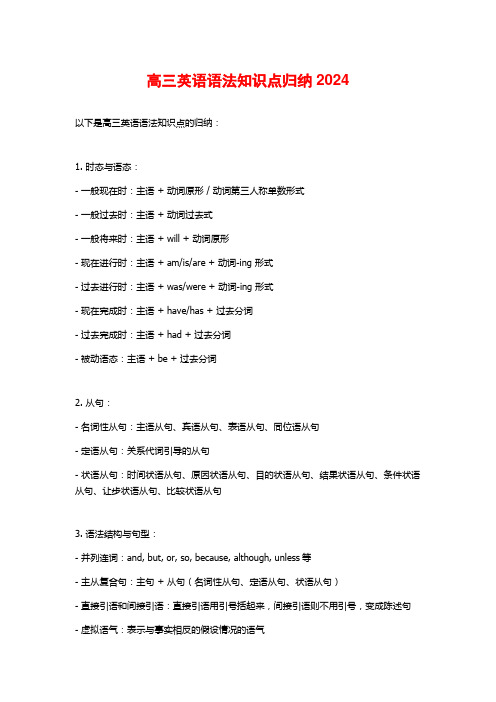
高三英语语法知识点归纳2024以下是高三英语语法知识点的归纳:1. 时态与语态:- 一般现在时:主语 + 动词原形 / 动词第三人称单数形式- 一般过去时:主语 + 动词过去式- 一般将来时:主语 + will + 动词原形- 现在进行时:主语 + am/is/are + 动词-ing 形式- 过去进行时:主语 + was/were + 动词-ing 形式- 现在完成时:主语 + have/has + 过去分词- 过去完成时:主语 + had + 过去分词- 被动语态:主语 + be + 过去分词2. 从句:- 名词性从句:主语从句、宾语从句、表语从句、同位语从句- 定语从句:关系代词引导的从句- 状语从句:时间状语从句、原因状语从句、目的状语从句、结果状语从句、条件状语从句、让步状语从句、比较状语从句3. 语法结构与句型:- 并列连词:and, but, or, so, because, although, unless等- 主从复合句:主句 + 从句(名词性从句、定语从句、状语从句)- 直接引语和间接引语:直接引语用引号括起来,间接引语则不用引号,变成陈述句- 虚拟语气:表示与事实相反的假设情况的语气- 倒装句:完全倒装、部分倒装4. 词类与词形变化:- 名词:单数形式、复数形式、可数名词和不可数名词的区分- 形容词:比较级、最高级、形容词和副词的区分- 动词:动词时态和语态的变化、及物动词和不及物动词的区别- 介词:表示位置、方向、时间、方式等关系5. 冠词和代词:- 冠词:定冠词the、不定冠词a/an的用法- 代词:人称代词、物主代词、反身代词、关系代词、指示代词、不定代词6. 句子成分:- 主语:句子的施事者或动作的承受者- 谓语:句子的核心,表示动作、状态或存在- 宾语:谓语动作的承受者或者是指示方向的对象- 表语:表示主语的性质、状态、身份等- 定语:修饰名词或代词- 状语:修饰动词、形容词、副词、整个句子,表示时间、地点、方式、原因等这些是高三英语语法知识点的一部分,希望对你有所帮助。
高三英语知识点汇总及讲解

高三英语知识点汇总及讲解英语是高中学习中一门重要的学科,掌握好英语知识点对于高三学生来说至关重要。
本文将对高三英语的知识点进行汇总和讲解,帮助同学们更好地备考。
一、语法知识点1. 时态和语态:包括一般现在时、一般过去时、一般将来时、现在进行时、过去进行时、现在完成时、被动语态等。
在时态和语态的使用上要注意动作发生的时间、状态的持续性以及动作的先后顺序等。
2. 名词:包括可数名词和不可数名词、复数形式、所有格的用法等。
名词在句子中可以作主语、宾语、表语等。
3. 代词:包括人称代词、指示代词、不定代词等。
代词在句子中可以替代名词或对名词进行修饰。
4. 动词:包括时态、语态、不同形式的用法等。
动词在句子中可以表示动作或状态。
5. 形容词和副词:形容词用来修饰名词,副词用来修饰动词、形容词或其他副词。
需要注意形容词和副词的比较级和最高级形式。
6. 冠词和介词:冠词包括定冠词和不定冠词,介词用来表示时间、地点、原因、方式等。
7. 从句:包括宾语从句、定语从句、状语从句等。
从句是句子的组成部分,用来修饰名词、动词或整个句子。
二、阅读技巧阅读理解是高考英语试卷中的一道重要题型,需要掌握一定的阅读技巧。
以下是一些阅读技巧的总结:1. 预读题目:在阅读文章之前,先浏览一下题目,了解大意和问题类型。
2. 找关键词:阅读文章时要留意关键词,比如数字、名词、动词等,有助于理解文章内容。
3. 注意上下文逻辑关系:通过上下文的逻辑关系可以推断出词义、句意等。
4. 注重细节:注意文章中的细节信息,有助于回答细节题。
5. 注意转折词和连接词:转折词和连接词能够帮助理解句子的关系和文章的结构。
三、写作技巧写作是英语考试的一个重要部分,以下是一些写作技巧:1. 扩充词汇量:写作时要注意使用多样化的词汇,避免重复使用相同的词语。
2. 遣词造句:合理选取词语和短语,使句子表达准确、清晰。
3. 句子结构多样化:尝试使用不同的句型,如倒装句、强调句、条件句等,使文章句式更加丰富。
2023年高考英语必背知识手册(思维导图+背诵手册):动词的时态及语态(解析版)

专题01动词的时态及语态时态知识梳理重点用法1一般现在时用法:1.be(am,is,are)动词的使用由主语的人称和数决定。
行为动词的第三人称单数加-s/es,其余人称用动词原形。
I am free tonight.我今晚有空。
The boy is ten years old.这个男孩10岁了。
They are students.他们是学生。
Bill often helps others.We like him a lot.比尔总是帮助他人。
我们很喜欢他。
2.表示经常、习惯性发生的动作或存在的状态。
It often rains in our city.我们的城市经常下雨。
3.表示普遍真理和客观真实。
The earth moves round the sun.地球围绕太阳转。
4.表示心理状态或情感的动词往往用一般现在时。
She hates rock music.她讨厌摇滚乐。
5.在时间、条件状语从句中表示将来的动作。
I will call on you as soon as I am free.我空闲时会去拜访你。
提示:一般现在时可以用来代替一般将来时,表示已经预先计划或安排的肯定将要发生的动作,句中常有表示将来时间的状语。
这一用法主要用于下列动词,如果arrive(到达),be(是),begin(开始),come(来到),go(去),leave(离开),reach(到达),start(出发)等。
The train leaves at eight o’clock.火车8点钟开车。
注意:一般现在时常用的时间状语有:today今天often经常always一直sometimes有时usually通常seldom很少on Sunday在星期天every day/week/morning每天/每周/每天早上重点用法2一般过去时用法:1.be(was/were)动词的使用由主语的人称和数决定。
行为动词都要用过去式。
高中英语知识点总结(高考必考)
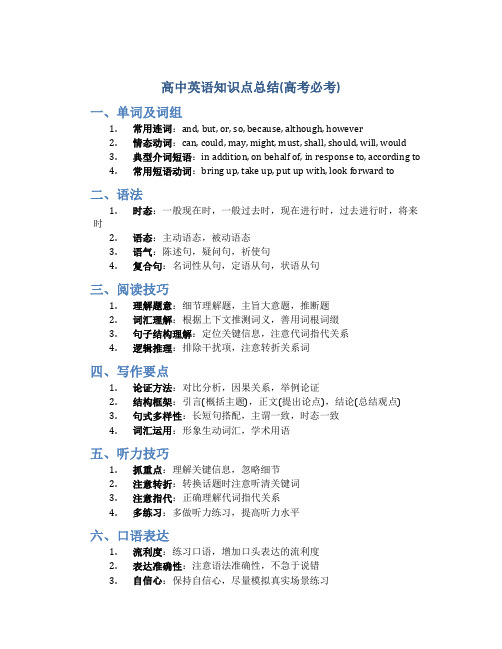
高中英语知识点总结(高考必考)一、单词及词组1.常用连词:and, but, or, so, because, although, however2.情态动词:can, could, may, might, must, shall, should, will, would3.典型介词短语:in addition, on behalf of, in response to, according to4.常用短语动词:bring up, take up, put up with, look forward to二、语法1.时态:一般现在时,一般过去时,现在进行时,过去进行时,将来时2.语态:主动语态,被动语态3.语气:陈述句,疑问句,祈使句4.复合句:名词性从句,定语从句,状语从句三、阅读技巧1.理解题意:细节理解题,主旨大意题,推断题2.词汇理解:根据上下文推测词义,善用词根词缀3.句子结构理解:定位关键信息,注意代词指代关系4.逻辑推理:排除干扰项,注意转折关系词四、写作要点1.论证方法:对比分析,因果关系,举例论证2.结构框架:引言(概括主题),正文(提出论点),结论(总结观点)3.句式多样性:长短句搭配,主谓一致,时态一致4.词汇运用:形象生动词汇,学术用语五、听力技巧1.抓重点:理解关键信息,忽略细节2.注意转折:转换话题时注意听清关键词3.注意指代:正确理解代词指代关系4.多练习:多做听力练习,提高听力水平六、口语表达1.流利度:练习口语,增加口头表达的流利度2.表达准确性:注意语法准确性,不急于说错3.自信心:保持自信心,尽量模拟真实场景练习4.词汇丰富性:扩充词汇量,让表达更加生动有趣以上是关于高中英语知识点总结的内容,希望对您的学习有所帮助。
祝您考试顺利!。
高考英语总复习(专题攻略)之词汇、短语与句型 动词时态和语态的必考考点归纳与详解

高考英语中动词时态和语态的必考考点归纳与详解(一)动词时态考查要点简述1. 一般现在时考点分析(1)表示客观事实或普通真理(不受时态限制)The geography teacher told us the earth moves around the sun.Water boils at 100oC.(2)表示现状、性质、状态时多用系动词或状态动词;表示经常或习惯性的动作,多用动作动词,且常与表频率的时间状语连用。
Ice feels cold.We always care for each other and help each other.(3)表示知觉、态度、感情、某种抽象的关系或概念的词常用一般现在时:see、hear、smell、taste、feel、notice、agree、believe、like、hate、want、think、belong seem 等。
如:Smith owns a car and a house.All the students here belong to No.1 Middle School.(4)在时间、条件状语从句中常用一般现在时代替将来时。
但要注意由if 引导的条件状语从句中可以用shall或will表“意愿”,但不表示时态。
If you will accept my invitation and come to our party, my family will be pleased.如果你愿意接受并参加我们的舞会,我的家人会非常高兴。
(5)少数用于表示起止的动词如come、go、leave、arrive、fly、return、start、begin、pen、close、end、stop等常用一般现在时代替将来时,表示一个按规定、计划或安排要发生的动作。
当be表示根据时间或事先安排,肯定会出现的状态,只用一般现在时。
The shop closes at 11:00 p.m. every day.Tomorrow is Wednesday.2. 一般过去时的考点分析(考核重点)。
- 1、下载文档前请自行甄别文档内容的完整性,平台不提供额外的编辑、内容补充、找答案等附加服务。
- 2、"仅部分预览"的文档,不可在线预览部分如存在完整性等问题,可反馈申请退款(可完整预览的文档不适用该条件!)。
- 3、如文档侵犯您的权益,请联系客服反馈,我们会尽快为您处理(人工客服工作时间:9:00-18:30)。
高考英语中动词时态和语态的必考考点归纳与详解(一)动词时态考查要点简述1. 一般现在时考点分析(1)表示客观事实或普通真理(不受时态限制)The geography teacher told us the earth moves around the sun.Water boils at 100oC.(2)表示现状、性质、状态时多用系动词或状态动词;表示经常或习惯性的动作,多用动作动词,且常与表频率的时间状语连用。
Ice feels cold.We always care for each other and help each other.(3)表示知觉、态度、感情、某种抽象的关系或概念的词常用一般现在时:see、hear、smell、taste、feel、notice、agree、believe、like、hate、want、think、belong seem 等。
如:Smith owns a car and a house.All the students here belong to No.1 Middle School.(4)在时间、条件状语从句中常用一般现在时代替将来时。
但要注意由if 引导的条件状语从句中可以用shall或will表“意愿”,但不表示时态。
If you will accept my invitation and come to our party, my family will be pleased.如果你愿意接受并参加我们的舞会,我的家人会非常高兴。
(5)少数用于表示起止的动词如come、go、leave、arrive、fly、return、start、begin、pen、close、end、stop等常用一般现在时代替将来时,表示一个按规定、计划或安排要发生的动作。
当be表示根据时间或事先安排,肯定会出现的状态,只用一般现在时。
The shop closes at 11:00 p.m. every day.Tomorrow is Wednesday.2. 一般过去时的考点分析(考核重点)。
(1)一般过去时的基本用法:表示过去的事情、动作或状态常与表示过去具体的时间状语连用(或有上下文语境暗示);用于表达过去的习惯;表示说话人原来没有料到、想到或希望的事通常用过去式。
如:I met her in the street yesterday.I once saw the famous star here.(2)如果从句中有一个过去的时间状语,尽管从句中的动作先于主句发生,但从句中的谓语动词连用过去式。
如:He told me he read an interesting novel last night.(3)表示两个紧接着发生的动作,常由以下词语连接,用一般过去时。
如:but, and, when, as soon as, immediately, the moment, the minute。
The moment she came in, she told me what had happened to her.He bought a watch but lost it.(4)常用一般过去时的句型:Why didn’t you / I think of that?I didn’t notice it.I forgot to tell you I had been there with my brother before.I didn’t recognize him.3. 一般将来时考点分析。
(1)表示未来的动作或状态常用will / shall + 动词(常与表示将来的时间状语边用如tomorrow、next week等)。
(2)表示一种趋向或习惯动作。
We’ll die without air or water.(3)表示趋向行为的动词如come、go、start、begin、leave等词常用进行时的形式表示将来时。
(4)be going to与will / shall, be to do, be about to do用法及区别:①be going to 表示现在打算在最近或将来要做某事,这种打算往往经过事先考虑,甚至已做了某种准备;shall / will do表示未事先考虑过,即说话时临时作出的决定。
②be going to 表将来,不能用在条件状语从句的主句中;而will则能,表意愿。
如:If it is fine, we’ll go fishing.(正确)If it is fine, we are going to go fishing.(错误)③be to do sth.表按计划、安排即将发生的动作,还可表示吩咐、命令、禁止,可能性等。
A meeting i s to be held at 3:00 o’clock this afternoon.④be about to do sth.表示“即可,就要”,后面不能接时间状语或状语从句。
Autumn harvest is about to start.4. 现在进行时考点分析。
(1)表示说话时正在发生着的一个动作;表示现阶段但不一定是发生在讲话时;表近期特定的安排或计划;go、come等起止动作可用进行时代替将来时。
如:I am meeting Mr. Wang tonight.We are leaving on Friday.At six I am bathing the baby.(I start bathing the bady before six.)The girl is always talking loud in public.(与always、often等频度副词连用,表经常反复的行动或某种感情色彩)(2)下面四类动词不宜用现在进行时。
①表示心理状态、情感的动作:like, love, hate, care, remember, believe, want, mind, wish, agree, mean, need。
②表存在的状态的动词:appear, exist, lie, remain, seem belong to, depend on。
③表示一时性动作的动词:allow, accept, permit, promise, admit, complete。
④表示感官的动词:see, hear, notice, feel, smell, sound, taste, look。
5. 过去完成时考点分析(考核重点)。
(1)常用过去完成时的几种情况:①在by、by the end、by the time、until、before、since后接表示过去某一时间的短语或从句以前发生的动作。
如:By the end of last year, we had produced 20,000 cars. The train had left before we reached the station.②表示曾实现的希望、打算、意图、诺言等。
常用had hoped / planned / meant / intended/ though / wanted / expected等或用上述动词过去式接不定式完成式表示即:hoped / planned … + to have done。
③“时间名词+ before”在句子中作状语,谓语动词用过去完成时;“时间名词+ ago”在句中作状语,谓语动词用一般过去式。
如:He said his first teacher had died at least10 years before. Xiao Hua left school 3 years ago.④表示“一……就”的几个句型:Hardly / No sooner / Scarcely had + 主语 + 过去分词 + when / than / before + 一般过去时。
如:We had no sooner been seated than the bus started. = No sooner had we been seated than the bus started.(2)在before或after引导的时间状语从句中用一般过去时态代替过去完成时。
After he (had)left the room, the boss came in.We arrived home before it snowed.6. 过去将来时考点分析。
参照一般将来时对比:用would do、was / were going to do sth.表过去将来;come、go、leave等过去进行时表过去将来时;was / were to do sth.和was / were about to do sth.表过去将来。
7. 过去进行时考点分析。
(1)过去某一时刻正在进行的动作或某一阶段内发生或频繁发生。
(2)某一动作发生时另一动作正在发生,其中一个在由when或while引导的时间状语从句中。
8. 现在完成时考点分析。
(1)现在完成时除可以和for、since引导的状语连用外,还可以和下面的介词短语连用:during / in /over the last(past)few years (months, weeks)、in recent years等。
(2)下列句型中常用现在完成时It is (has been) + 一段时间 + since从句This(That / It)is the first(second…)time that + 完成时T his(That / It)is the only … + that + 完成时This(that / It)is the best / finest / most interesting … + that 从句 + 完成时(3)在时间或条件状语从句中,现在完成时可以代替一般将来时。
如:I shall post the letter as soon as I have written it.If you have done the experiment, you will realize the theory better.Don’t get off the bus until it has stopped.9. 注意几组时态的区别:(1)一般过去时与现在完成时:时间上有差异:凡有过去时间的均用过去时态,不能用完成时态,如含有ago、last year、just now、the other day等。
结果上有差异:现在完成时强调的是对“现在”的影响和结果,动作到现在刚完成或还在继续;一般过去时强调的是动作发生在“过去”,和现在毫无关系。
